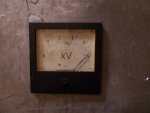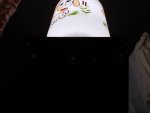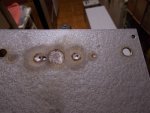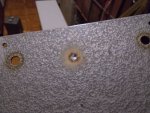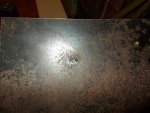- Joined
- Dec 4, 2016
- Messages
- 197
- Points
- 43
Here I'm starting a thread about the most high-energy laser that had ever been manufactured commercially for general lab use. The GOS-1001 Nd:Glass laser, that is rated for 1000 J of output energy! And it is the true peak of my collection. A few days ago I managed to get first coherent photons from it.
So, I had a complete laser head but no power supply. A year or two ago I've bought 32 high energy high voltage capacitors for it but didn't do anything with them because I was busy building my other laser projects, such as ruby and copper vapour lasers. After finishing the CVL, I put hands on the GOS-1001 unit. Actually I needed only a power supply to charge the capacitors and triggering circuits for all four flashlamps, a water circulator to cool the laser head and loads of space in the room to put everything together. After a month of work, I mde first flashes of the lamps separately. After verifying that the lamps flash at the same time I've rebuilt the power supply into a final version. During the rebuilding I had to rewind the charging transformer and all 4 triggering transformers, as their electrical insulation was poor and it lead to failures. A real problem was to stack the capacitors. unfortunately I couldn't stack all 32 caps, as I found place only for 20 of them. In the manual for the laser head it is said that reliable lasing is at 20 kJ of pumping and the lasing threshold is at 15 kJ. my laser head is very old, the optical elements such as resonator mirrors and lamp reflectors are worn a lot, so I expected a real lasing threshold at 20 kJ. 20 caps allow to store safely exactly 20 kJ, and 25 when fully loaded. So I had a doubt wether it will lase at all.
Afterall the power unit was assembled. It was a hard job to pile up 250 kg of capacitors and to wire them together. It was the turn of the water cooling system. Two days I have been fiddling with it as new and new water leaks appeared. After finishing this part of the job I've refreshed the insulation of internal wiring of the laser head, cleaned carefully all optics and flashlamps, aligned the resonator, installed in place the focusing lens and the target behind it... And it was ready for the first blast after very long period of collecting dust in the lab from which I had salvaged it.
I charged the caps to 9 kJ of energy and hit the firing button. The result
exceeded all expectations -- I've seen a lot of smoke from the target that was made of black plastic. The GOS1001 definately lased. Than I placed a 3mm thick steel plate and made anothe shot. I saw a heavy bunch of sparks with a loud bang flying away from the target. And than a second shot in the same place. Looking at light, I've seen a tiny hole through this plate.
I tried increasing the pumpung energy to 20 kJ, but I could not shoot through this steel plate in a single shot -- the blast area increased in diameter in the hit point but it didn't go deep. And I found the reason quickly.
Unfortunately, the focusing lens was short-focused so it was badly damaged with the plasma stream from burning steel. The surface of the lens became rough and the lens lost its transparancy. So, probably the focusing became too bad.
I've measured the output energy on 9 kJ point with my laser energy meter and it showed 27J average... I didn't measure it on 20 kJ, as I'm afraid that the energy meter will be screwed.
I'll remind that 1000J of energy it should blast from at least of 50 kJ of pumping...
Now I need a new focusing lens, with f=30cm at least. And a bigger room:yh::yh::yh:
Unfortunately it is very hard to capture the moment when the beam hits the target. The flash overloads the camera badly, so nearly nothing can be seen except white filling of the screen. So the photos are not very good.
So, I had a complete laser head but no power supply. A year or two ago I've bought 32 high energy high voltage capacitors for it but didn't do anything with them because I was busy building my other laser projects, such as ruby and copper vapour lasers. After finishing the CVL, I put hands on the GOS-1001 unit. Actually I needed only a power supply to charge the capacitors and triggering circuits for all four flashlamps, a water circulator to cool the laser head and loads of space in the room to put everything together. After a month of work, I mde first flashes of the lamps separately. After verifying that the lamps flash at the same time I've rebuilt the power supply into a final version. During the rebuilding I had to rewind the charging transformer and all 4 triggering transformers, as their electrical insulation was poor and it lead to failures. A real problem was to stack the capacitors. unfortunately I couldn't stack all 32 caps, as I found place only for 20 of them. In the manual for the laser head it is said that reliable lasing is at 20 kJ of pumping and the lasing threshold is at 15 kJ. my laser head is very old, the optical elements such as resonator mirrors and lamp reflectors are worn a lot, so I expected a real lasing threshold at 20 kJ. 20 caps allow to store safely exactly 20 kJ, and 25 when fully loaded. So I had a doubt wether it will lase at all.
Afterall the power unit was assembled. It was a hard job to pile up 250 kg of capacitors and to wire them together. It was the turn of the water cooling system. Two days I have been fiddling with it as new and new water leaks appeared. After finishing this part of the job I've refreshed the insulation of internal wiring of the laser head, cleaned carefully all optics and flashlamps, aligned the resonator, installed in place the focusing lens and the target behind it... And it was ready for the first blast after very long period of collecting dust in the lab from which I had salvaged it.
I charged the caps to 9 kJ of energy and hit the firing button. The result
exceeded all expectations -- I've seen a lot of smoke from the target that was made of black plastic. The GOS1001 definately lased. Than I placed a 3mm thick steel plate and made anothe shot. I saw a heavy bunch of sparks with a loud bang flying away from the target. And than a second shot in the same place. Looking at light, I've seen a tiny hole through this plate.
I tried increasing the pumpung energy to 20 kJ, but I could not shoot through this steel plate in a single shot -- the blast area increased in diameter in the hit point but it didn't go deep. And I found the reason quickly.
Unfortunately, the focusing lens was short-focused so it was badly damaged with the plasma stream from burning steel. The surface of the lens became rough and the lens lost its transparancy. So, probably the focusing became too bad.
I've measured the output energy on 9 kJ point with my laser energy meter and it showed 27J average... I didn't measure it on 20 kJ, as I'm afraid that the energy meter will be screwed.
I'll remind that 1000J of energy it should blast from at least of 50 kJ of pumping...
Now I need a new focusing lens, with f=30cm at least. And a bigger room:yh::yh::yh:
Unfortunately it is very hard to capture the moment when the beam hits the target. The flash overloads the camera badly, so nearly nothing can be seen except white filling of the screen. So the photos are not very good.
Attachments
-
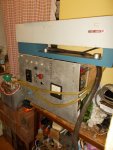 DSCN5092.JPG157.7 KB · Views: 69
DSCN5092.JPG157.7 KB · Views: 69 -
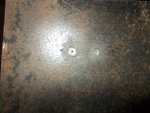 DSCN5085.JPG299.3 KB · Views: 68
DSCN5085.JPG299.3 KB · Views: 68 -
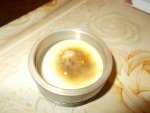 DSCN5089.JPG169.8 KB · Views: 132
DSCN5089.JPG169.8 KB · Views: 132 -
![DSCN5079.AVI_snapshot_00.43_[2018.05.05_18.42.41].jpg](/data/attachments/43/43623-01768392414b4616c31cafa682a7ae07.jpg?hash=AXaDkkFLRh) DSCN5079.AVI_snapshot_00.43_[2018.05.05_18.42.41].jpg91.9 KB · Views: 75
DSCN5079.AVI_snapshot_00.43_[2018.05.05_18.42.41].jpg91.9 KB · Views: 75 -
![DSCN5079.AVI_snapshot_00.43_[2018.05.05_18.43.03].jpg](/data/attachments/43/43624-346b9ccbb4cad635d5aa3ef56b8a23d8.jpg?hash=NGucy7TK1j) DSCN5079.AVI_snapshot_00.43_[2018.05.05_18.43.03].jpg91.3 KB · Views: 69
DSCN5079.AVI_snapshot_00.43_[2018.05.05_18.43.03].jpg91.3 KB · Views: 69 -
![DSCN5112.AVI_snapshot_00.32_[2018.05.07_20.28.03].jpg](/data/attachments/43/43625-48bf47c027b4fa7dce46f828825b2491.jpg?hash=SL9HwCe0-n) DSCN5112.AVI_snapshot_00.32_[2018.05.07_20.28.03].jpg113.3 KB · Views: 62
DSCN5112.AVI_snapshot_00.32_[2018.05.07_20.28.03].jpg113.3 KB · Views: 62 -
![DSCN5107.AVI_snapshot_00.02_[2018.05.07_20.15.01].jpg](/data/attachments/43/43626-1bdc171da6240f4e80c44beee5da7174.jpg?hash=G9wXHaYkD0) DSCN5107.AVI_snapshot_00.02_[2018.05.07_20.15.01].jpg100.2 KB · Views: 59
DSCN5107.AVI_snapshot_00.02_[2018.05.07_20.15.01].jpg100.2 KB · Views: 59 -
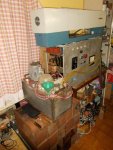 DSCN5091.JPG174.8 KB · Views: 78
DSCN5091.JPG174.8 KB · Views: 78




![DSCN5123.AVI_snapshot_00.02_[2018.05.09_23.41.15].jpg](/data/attachments/43/43654-ac318e53c99f122c75275933d04416dc.jpg?hash=rDGOU8mfEi)
![DSCN5129.AVI_snapshot_00.02_[2018.05.09_23.51.10].jpg](/data/attachments/43/43659-66a38d7c910294cfeef4e055a420bee3.jpg?hash=ZqONfJEClM)
![DSCN5126.AVI_snapshot_00.03_[2018.05.09_23.45.57].jpg](/data/attachments/43/43658-c1cea0198292b81ae2caa62f8ce1420f.jpg?hash=wc6gGYKSuB)
![DSCN5124.AVI_snapshot_00.02_[2018.05.09_23.44.19].jpg](/data/attachments/43/43657-fa86f259c516d5afc1c3eb3a71996168.jpg?hash=-obyWcUW1a)
![DSCN5124.AVI_snapshot_00.02_[2018.05.09_23.43.47].jpg](/data/attachments/43/43656-2cba04bb8026d6b0f54372f781fa4406.jpg?hash=LLoEu4Am1r)
![DSCN5123.AVI_snapshot_00.02_[2018.05.09_23.41.40].jpg](/data/attachments/43/43655-b37c6615d2c1627c6907d61ae0534873.jpg?hash=s3xmFdLBYn)
![DSCN5127.AVI_snapshot_00.03_[2018.05.09_23.48.06].jpg](/data/attachments/43/43653-e131e82ff72bd2ac4c7023e5d6aeed25.jpg?hash=4THoL_cr0q)
